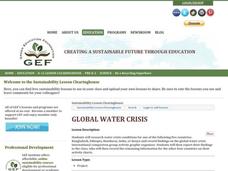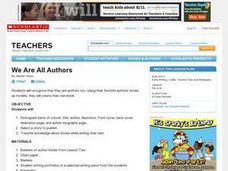Curated OER
Addition Practice
Give your mathematicians a leg up on simple addition using this activity with visual aids. Similar to counting cubes, each single-digit addend is accompanied by a corresponding number of colored squares. The two colors are joined where...
Curated OER
Greatest Common Factor
Given 10 number pairs, learners find the greatest common factor for each. For several, one of the numbers is the greatest common factor, and for others mathematicians will need to think a little harder. There space for learners to show...
Curated OER
Least Common Multiple
Given ten pairs of numbers, mathematicians find the least common multiple for each. The numbers span from 2-30, and are generally introductory for this skill (no curve balls). Encourage learners to write out multiples alongside the...
Curated OER
Draw the Hands
A set of analog clock-faces (sans the hands) give learners nine opportunities to practice telling time. They draw in the minute and hour hands based on times written below each clock face. Times are either on the hour or the half-hour....
Curated OER
Coin Comparison Worksheet
Use this one-page worksheet to assess young learners’ ability to correctly compare a series of coins. Each problem asks counters to indicate with the correct symbol whether the total value of the coins in the left column is greater than,...
Curated OER
Styrofoam Relief Prints
Using Styrofoam trays, kindergartners carve and create their own prints. They create an image in the Styrofoam, ink it up, and then use it to create prints. It would be great to mention and show how ink blocks or block prints have been...
Curated OER
Same-Sex Schools Gain Ground
High schoolers examine the issue of having same-sex classes. Using the internet, they research how this program is working around the country. They interview local education experts and determine how they view the issue. They include an...
Curated OER
Eating Under the Rainbow
Students investigate the lure of snack-food advertisements to explain how snacks can fit into a healthy diet.
Curated OER
Introduction To Literary Analysis
Explore the fascinating ways in which authors use specific literary devices to create interesting and realistic texts. Using non-fiction articles with the subject of rogue waves, an excerpt from The Perfect Storm, by Sebastian Junger,...
Curated OER
Graphing on the Computer
Learners create a bar graph on the computer using given information from the teacher. They create a bar graph using their own information chart (they need to create one on separate paper first). They utilize Microsoft Excel for this lesson.
Curated OER
Basic Visual Language
Students gain knowledge of the basics of visual communication. They are introduced to the three fundamental elements of visual language. Those are: camera angle, lighting, and compositions. Students video each other from different angles...
Curated OER
"get a Life!" Career Exploration Project
Young scholars read and discuss The Application handout. They assemble a Master Job Application so they have all the information needed for a job application correctly compiled in one place. They determine a pencil never good enough for...
Curated OER
Global Water Crisis
Assign ecologists one of five countries that struggle with access to clean water. They research the water crisis in that country and then present information to classmates. A handout was designed for each country, and a worksheet on...
Curated OER
Design Explorations: Frieze Patterns
Students will explore frieze patterns. A frieze pattern is a mathematical concept to classify designs on two-dimensional surfaces, which are repetitive in one direction, based on the symmetries in the pattern. They will explore examples...
Curated OER
Cross-Curricular Games
Students participate in exploring and examining several cross-curricular, hands-on games that encourage active learning and exercise at the same time. They assess games like Freeze Tag, Parts of Speech games and a healthy heart game, etc.
Curated OER
Pressing and Seam Finishes
This lesson addresses proper seam allowances, how those seams should be finished, and the importance of pressing them. Class members learn by listening as well as by practicing and creating their own samples. There are many attachments...
Curated OER
Racial discrimination against the Chinese in the late 19th and early 20th centuries
Students examine the stereotypes of Chinese immigrants to Australia in the late 19th and early 20th centuries. They evaluate the validity of these stereotypes and investigate various pieces of legislation that discriminated against the...
Curated OER
Literacy Lesson: Guided Reading
Here is a wonderful instructional activity designed for students with special needs. This well-thought-out instructional activity uses Big Books, familiar stories, and has a lot of review learning built into it. The book, The Keeping...
Curated OER
Personal Narrative Paragraphs: Class Quilt
Begin this activity by asking third graders to bring from home pieces of cloth that represent something important to them. (Have extras for learners who need them.) They reflect on important events in their lives, compose narrative...
Curated OER
How to Write an Essay: Secondary ed.
Whether introducing the structure of expository essays or reviewing the format with your high schoolers, take the time to check out this resource. Examples of seven common forms of introductory paragraphs and six types of conclusions, as...
Curated OER
We Are All Authors
Students analyze the components of a book to use it as a model for the creation of their own book. The title, author, illustrator, front cover, back cover, dedication page, and author are examined in this lesson.
Curated OER
Crayon Resist
Kids usually love crayon resist projects. It is so fascinating for them to see how the dark paint accentuates and resists the waxy crayon. Here are instructions for executing a crayon resist project of your own. Tip: Make the project fit...
Curated OER
Relief Foil Sculpture
A little tin foil can go a long way. Middle schoolers create relief sculptures out of card board and foil. The step-by-step procedure and materials list are included. Note: This project can be done with children as young as seven.

























